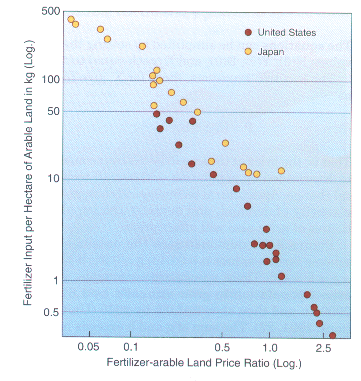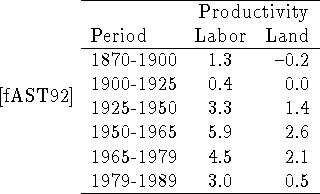Technology left on the shelf butters no parsnips. Whether it will be employed depends on the profit the farmer foresees or the rules that discourage her. In Transforming Traditional Agriculture, Schultz (1964[Sch64]) argued that even poor farmers in poor places do profitable things.
The book with the illuminating title The Bias Against Agriculture (Bautista and Valdes, 1993[Bau93]) tells how societies have both discouraged and encouraged farm production. For example, for decades Argentina maintained a large and inefficient public sector and overvalued the peso, slowing agricultural growth below the rates in other countries producing grain and livestock. In Peru during 1969-1973, industrial protection and price controls on farm products cut the production of farm products. In Zaire during 1966-1982, price controls on food to depress real wages, as well as taxes on exports to provide cheap credit for industry, were designed to encourage industry; they cut the growth of food production from 4.0 to 1.6% and production of export crops even more. None of these workings of an invisible hand to encourage and discourage production would have surprised Adam Smith.
An invisible hand
also induces invention and application
of technology by persons and institutions. Hayami
and Ruttan (1985[HR85])![]() showed how the ratio of fertilizer
to land prices induced about the same response in
applications of fertilizer in countries as unlike as Japan
and the United States (Figure 8.3.1.).
They also
showed how passing time changed both the output per
worker and per area similarly in different countries.
showed how the ratio of fertilizer
to land prices induced about the same response in
applications of fertilizer in countries as unlike as Japan
and the United States (Figure 8.3.1.).
They also
showed how passing time changed both the output per
worker and per area similarly in different countries.
 Figure 8.3.1. How similar ratios of fertilizer and land prices in
dissimilar countries induced similar response in
fertilizer rates: Japan and United States, 1880-1980
(prepared by V. W. Ruttan for the Council for
Agricultural Science and Technology, 1992; Hayami
and Ruttan, 1985). [fAST92][HR85]
Figure 8.3.1. How similar ratios of fertilizer and land prices in
dissimilar countries induced similar response in
fertilizer rates: Japan and United States, 1880-1980
(prepared by V. W. Ruttan for the Council for
Agricultural Science and Technology, 1992; Hayami
and Ruttan, 1985). [fAST92][HR85]
Table 8.3.1 aptly illustrates the induction of technology. During the nineteenth century, when labor was short and land long in the United States, new plows, reapers, and thrashers raised the productivity of labor, but the productivity of abundant land fell. Then after the Frontier closed, land grew dearer, and science and extension developed, land productivity rose, too.

Table 12.3: Percentage change per year in productivity of U.S.
agriculture (prepared by V. W. Ruttan for the
Council for Agriculture Science and Technology,
1992)
Behind the hope often billion people's sparing land for Nature lies the assumption of society's making rules and holding out incentives, first to induce invention and application of technology to raise yields per plot and second to encourage farmers to grow more per plot.